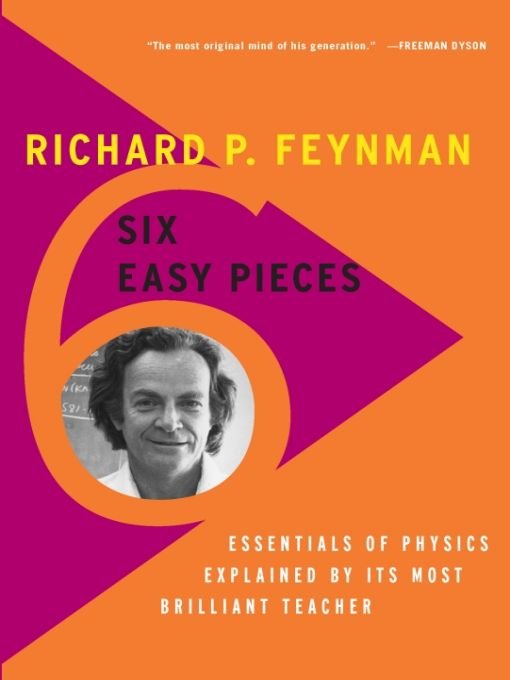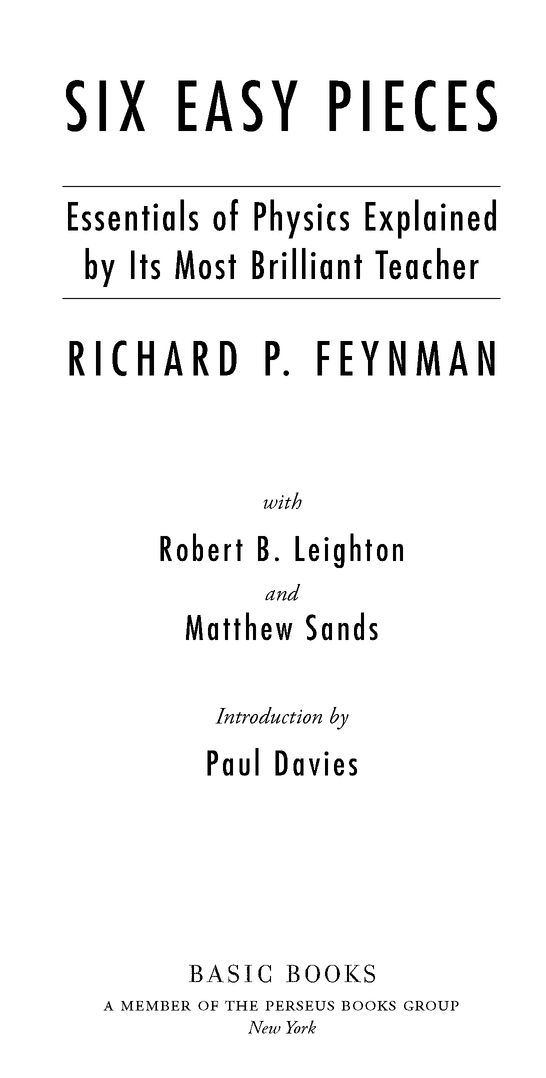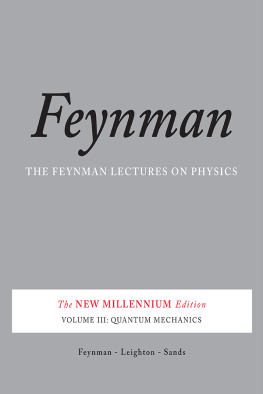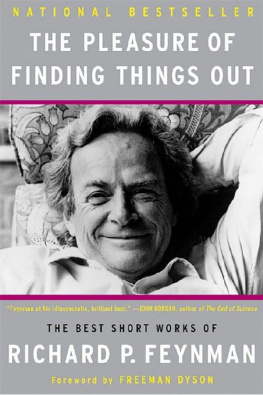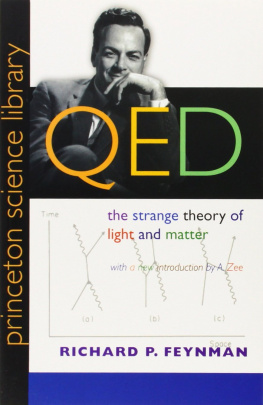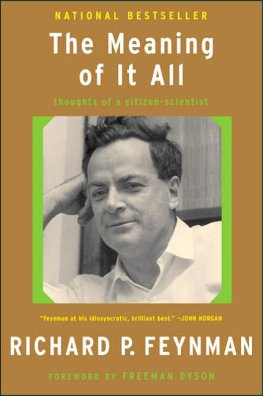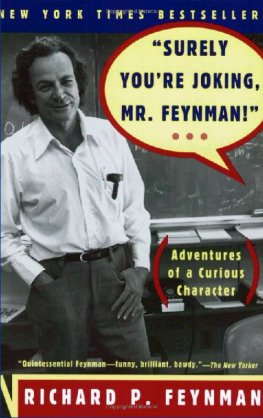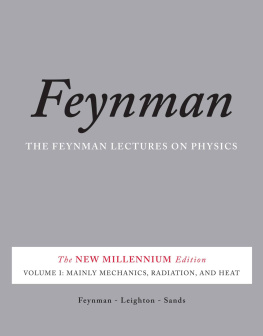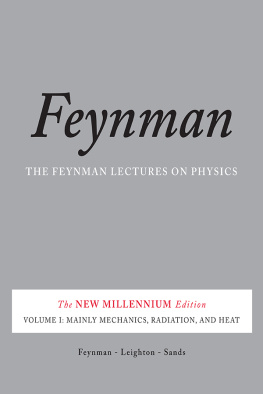Table of Contents
Also by Richard P. Feynman
The Character of Physical Law
Elementary Particles and the Laws of Physics:
The 1986 Dirac Memorial Lectures (with Steven Weinberg)
Feynman Lectures on Computation
(edited by Anthony J. G. Hey and Robin Allen)
Feynman Lectures on Gravitation (with Fernando B. Morinigo and
William G. Wagner; edited by Brian Hatfield)
The Feynman Lectures on Physics
(with Robert B. Leighton and Matthew Sands)
The Meaning of It All: Thoughts of a Citizen-Scientist
Photon-Hadron Interactions
Perfectly Reasonable Deviations from the Beaten Track:
The Letters of Richard P. Feynman
The Pleasure of Finding Things Out.
The Best Short Works of Richard P. Feynman
QED: The Strange Theory of Light and Matter
Quantum Mechanics and Path Integrals (with A. R. Hibbs)
Six Not-So-Easy Pieces:
Einsteins Relativity Symmetry and Space Time
Statistical Mechanics: A Set of Lectures
Surely You re joking Mr. Feynman!
Adventures of a Curious Character (with Ralph Leighton)
The Theory of Fundamental Processes
What Do You Care What Other People Think?
Further Adventures of a Curious Character
(with Ralph Leighton)
PUBLISHERS NOTE
Six Easy Pieces grew out of the need to bring to as wide an audience as possible a substantial yet nontechnical physics primer based on the science of Richard Feynman. We have chosen the six easiest chapters from Feynmans celebrated and landmark text, The Feynman Lectures on Physics (originally published in 1963), which remains his most famous publication. General readers are fortunate that Feynman chose to present certain key topics in largely qualitative terms without formal mathematics, and these are brought together for Six Easy Pieces.
We would like to thank Paul Davies for his insightful introduction to this newly formed collection. Following his introduction we have chosen to reproduce two prefaces from The Feynman Lectures on Physics, one by Feynman himself and one by two of his colleagues, because they provide context for the pieces that follow and insight into both Richard Feynman and his science.
Finally, we would like to thank the California Institute of Technologys Physics Department and Institute Archives, in particular Dr. Judith Goodstein, and Dr. Brian Hatfield, for his outstanding advice and recommendations throughout the development of this project.
INTRODUCTION
There is a popular misconception that science is an impersonal, dispassionate, and thoroughly objective enterprise. Whereas most other human activities are dominated by fashions, fads, and personalities, science is supposed to be constrained by agreed rules of procedure and rigorous tests. It is the results that count, not the people who produce them.
This is, of course, manifest nonsense. Science is a people-driven activity like all human endeavor, and just as subject to fashion and whim. In this case fashion is set not so much by choice of subject matter, but by the way scientists think about the world. Each age adopts its particular approach to scientific problems, usually following the trail blazed by certain dominant figures who both set the agenda and define the best methods to tackle it. Occasionally scientists attain sufficient stature that they become noticed by the general public, and when endowed with outstanding flair a scientist may become an icon for the entire scientific community. In earlier centuries Isaac Newton was an icon. Newton personified the gentleman scientistwell connected, devoutly religious, unhurried, and methodical in his work. His style of doing science set the standard for two hundred years. In the first half of the twentieth century Albert Einstein replaced Newton as the popular scientist icon. Eccentric, dishevelled, Germanic, absent-minded, utterly absorbed in his work, and an archetypal abstract thinker, Einstein changed the way that physics is done by questioning the very concepts that define the subject.
Richard Feynman has become an icon for late twentieth-century physicsthe first American to achieve this status. Born in New York in 1918 and educated on the East Coast, he was too late to participate in the Golden Age of physics, which, in the first three decades of this century, transformed our worldview with the twin revolutions of the theory of relativity and quantum mechanics. These sweeping developments laid the foundations of the edifice we now call the New Physics. Feynman started with those foundations and helped build the ground floor of the New Physics. His contributions touched almost every corner of the subject and have had a deep and abiding influence over the way that physicists think about the physical universe.
Feynman was a theoretical physicist par excellence. Newton had been both experimentalist and theorist in equal measure. Einstein was quite simply contemptuous of experiment, preferring to put his faith in pure thought. Feynman was driven to develop a deep theoretical understanding of nature, but he always remained close to the real and often grubby world of experimental results. Nobody who watched the elderly Feynman elucidate the cause of the Challenger space shuttle disaster by dipping an elastic band in ice water could doubt that here was both a showman and a very practical thinker.
Initially, Feynman made a name for himself from his work on the theory of subatomic particles, specifically the topic known as quantum electrodynamics or QED. In fact, the quantum theory began with this topic. In 1900, the German physicist Max Planck proposed that light and other electromagnetic radiation, which had hitherto been regarded as waves, paradoxically behaved like tiny packets of energy, or quanta, when interacting with matter. These particular quanta became known as photons. By the early 1930s the architects of the new quantum mechanics had worked out a mathematical scheme to describe the emission and absorption of photons by electrically charged particles such as electrons. Although this early formulation of QED enjoyed some limited success, the theory was clearly flawed. In many cases calculations gave inconsistent and even infinite answers to well-posed physical questions. It was to the problem of constructing a consistent theory of QED that the young Feynman turned his attention in the late 1940s.
To place QED on a sound basis it was necessary to make the theory consistent not only with the principles of quantum mechanics but with those of the special theory of relativity too. These two theories come with their own distinctive mathematical machinery, complicated systems of equations that can indeed be combined and reconciled to yield a satisfactory description of QED. Doing this was a tough undertaking, requiring a high degree of mathematical skill, and was the approach followed by Feynmans contemporaries. Feynman himself, however, took a radically different routeso radical, in fact, that he was more or less able to write down the answers straightaway without using any mathematics!
To aid this extraordinary feat of intuition, Feynman invented a simple system of eponymous diagrams. Feynman diagrams are a symbolic but powerfully heuristic way of picturing what is going on when electrons, photons, and other particles interact with each other. These days Feynman diagrams are a routine aid to calculation, but in the early 1950s they marked a startling departure from the traditional way of doing theoretical physics.

